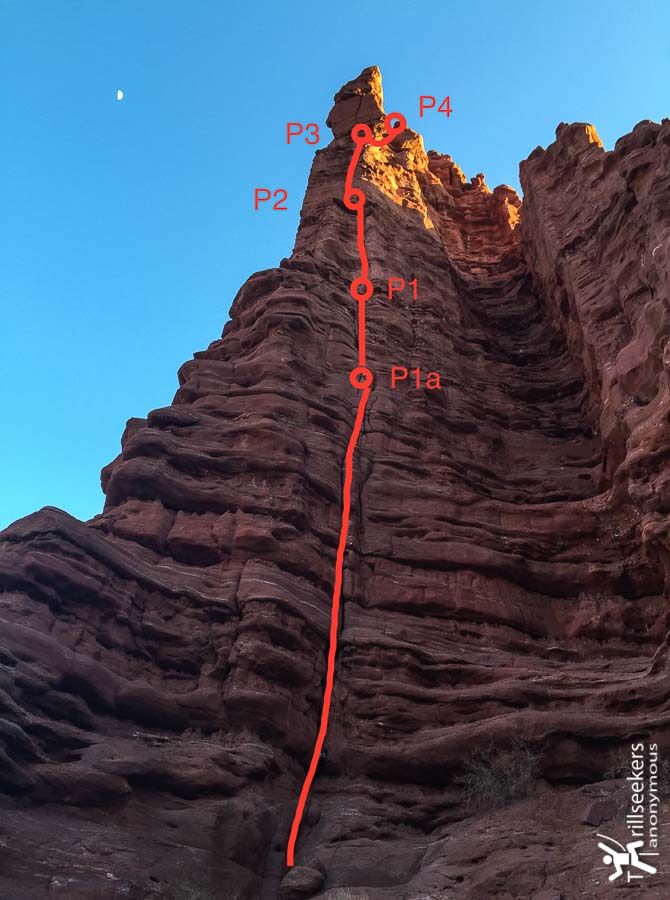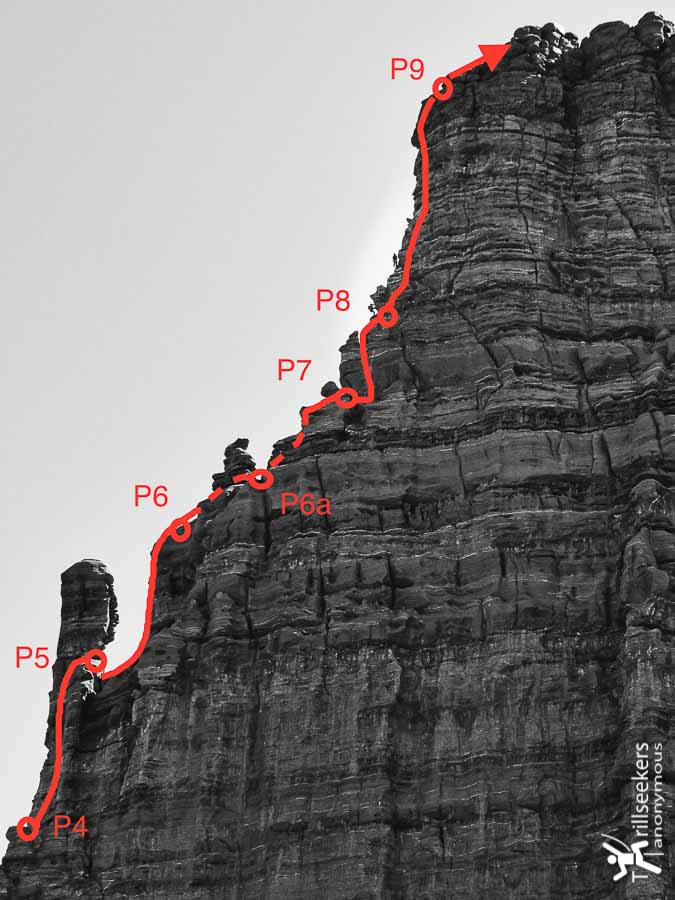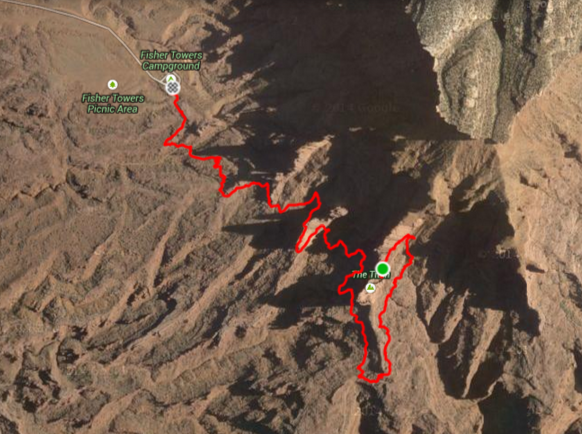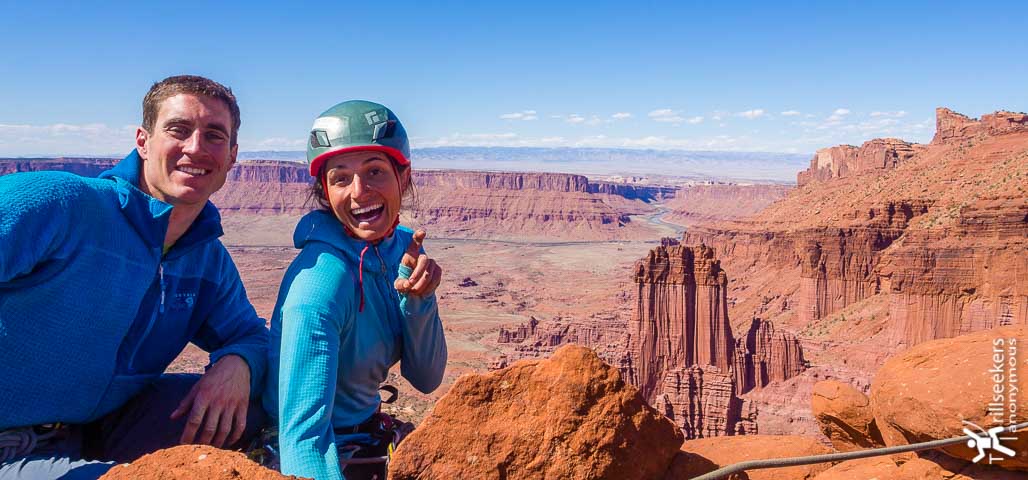JUMP TO: Route Description • Logistics • Photo Album
The tallest sand-“stone” tower in North America and the Western hemisphere, and a route name that reminds me of the ceiling of Michelangelo’s Sistine Chapel sounds dreamy. But, maybe it’s all the sand in my eyes. I had wanted to climb the Titan’s Finger of Fate since my first year of climbing when I managed to scrape my way up ‘Ancient Art’ in the Fischer Towers. Everyone kept telling me I should go climb something else. A good friend, Charles Keeling, quoted me Layton Kor during the 1962 first ascent with Huntley Ingalls and George Hurley as having said, “We are all going to die up here but, man this is going to be a classic.” I could not source Charles Keeling’s quote but it definitely flashed through my head while on route more than once.
 A week long spring break trip that saw Washer Woman’s In Search of Suds, Monster Tower’s North Ridge, and Moses’ Primrose Dihedrals and Pale Fire needed a capstone moment,and I was determined the Titan would be it. Doing laundry next to Gearheads, I casually left my climbing partners to wander next door in search of sawed off pitons. My online research had convinced me if I had an oh-shit moment, these heavy relics of a bygone era would save the day. 80 dollars later I had 4 angles (they sadly did not carry saw offs) and even more sadly, no one in Gearheads, had climbed the tower to give me a spray down – though I do really appreciate their free water. I walked back to the end of laundry folding (which I might have been strategically absent from) in time to suggest truncating the rest day so we could go fix the first 3 pitches of the Titan.
A week long spring break trip that saw Washer Woman’s In Search of Suds, Monster Tower’s North Ridge, and Moses’ Primrose Dihedrals and Pale Fire needed a capstone moment,and I was determined the Titan would be it. Doing laundry next to Gearheads, I casually left my climbing partners to wander next door in search of sawed off pitons. My online research had convinced me if I had an oh-shit moment, these heavy relics of a bygone era would save the day. 80 dollars later I had 4 angles (they sadly did not carry saw offs) and even more sadly, no one in Gearheads, had climbed the tower to give me a spray down – though I do really appreciate their free water. I walked back to the end of laundry folding (which I might have been strategically absent from) in time to suggest truncating the rest day so we could go fix the first 3 pitches of the Titan.
We rolled up to the Fisher Towers at a casual 2pm and managed to score the last camping site, (in)conveniently next to the campground pooper. Not that this discouraged incompetent tourists from trying to evict us due to their camping manner negligence or normal climbers from simply crashing in the parking lot.
We set out on the approach, which I am convinced was the longest 3 miles of my life and it was not even three miles (2.7). As you walk along the base of the towers, perspective becomes warped as these giant colossuses tower above you, and you attempt to rationalize with yourself that they are not so tall. The furthest of the Fisher Towers, naturally, is the Titan.
We racked up at the base. Wow are triples heavy, but I guess it’s best to be prepared for an adventure. I carried triples from Aliens through a number three, a number four, nuts, micro nuts and four pitons which add up to a significant weight belt.
Route Description
Finger of Fate (5.8 C2+, 9 pitches)
>> download topo (courtesy of Pete Robins/Ben Bransby, FFA)
Note on the rating: I decided against validating the aid ratings as this requires me to fall, measure how far I fell, and count how many pieces of gear ripped. Aid climbers are crazy.
 |
 |
APPROACH: From Moab (45min), head to the west end of town and then drive north on UT-128 for 21 miles, past Castle Valley, turning right on Fisher Towers Road and following that for ~2 miles. Park at the campground parking area and follow the obvious trail on foot nearly to its end, passing the base of the Titan, and then wrapping around its flank to climb up its backside to the saddle. From here the start of the route is obvious; a pair of dancing cracks splitting and merging, shooting straight upwards to the Titan’s North East Ridge and the Finger of Fate. The approach is only 2.7 miles, but tedious, so allow about an hour with gear.

Pitch 1 (100 feet): At some point sand ends and mud begins. The two cracks weave their way upwards and the climbing, at least before I started, looked fun. I had plans to free the route and abandoned them halfway up this pitch. As my feet deteriorate, blinded by the mud patina that poured into my eyes, I came to the conclusion triples was inadequate pro and I had zero intention of running out 40 feet to the first anchor. I yelled “block” because it sounds better in French, and adjusted my dream to summiting. After equalizing 4 pieces, I lowered back to the base to back clean gear from the bottom because I had no intention of pulling any of the gear higher up. Continuing upwards, I made the first of several beautifully bolted anchors. (Whoever cleaned all the tat off the route and made the anchors a little oasis of safety, shoot me a message. I want to buy you a beer, and not the Utah 3.2 kind, but a real honest to goodness beer.)
Pitch 1.2 (40 feet): Having stopped at the first set of anchors (which apparently only counts as two-thirds of the first pitch). I continued up the cracks to the proper end of pitch one. Kudos to you if you manage the über pitch.
Pitch 2 (70 feet): This pitch looks like brilliant climbing, it just turns out not to be. The slightly overhung seam provides good finger locks and some fairly solid cam placements (purple BD, grey and yellow aliens). The stemming proves the challenge as my feet kept shooting off the crumbly sand as I tried to establish a stem. The fact this pitch is half the length of pitch 1 made me happy. I let out a little sigh of relief as I pulled the final long move to clip the anchor. Unfortunately or fortunately this is by far the worst belay on route, happy hanging.
Pitch 3 (80 feet): I thought this was, hands down, the crux of the route – emotionally and technically but emphasis on emotionally. A series of roofs with progressively sketchier pro – the type climbers from Boulder describe as “adequate” when talking about X-rated routes making me wonder why I climb; I need a hobby that involves a zero gravity lawn chair and a fruity drink. The pitch started with me hand placing and tying off a piton – the only piton I used on route, and the gear did not get better from there. This was by far the muddiest pitch of the entire route, which is saying something, and having no skills as an aid climber, I was forced to pull some free moves above gear I did not want to yank on, let alone fall take a fall on. The higher I got, the muddier and worse the pro. I made the anchor, which felt like I had made it to Michelangelo’s Pearly Gates. I was not sure whether to become religious or poop myself. Stuck with this dilemma, I fixed the rope and rapped down, absolutely traumatized from 3 hours of “rest day” climbing.
After a nervous night’s sleep, filled entirely with nightmares of pitch 3 and a lot of apprehension about what the upper portion of the route would have in store for us, we were both wide awake at sunrise. Groups were already starting out for Ancient Art at o-dark-thirty. We trudged back to the start of the route (remind me to do this in a day next time) and jugged up the ropes we had fixed the day before. The jugging went quickly, even on our dynamic ropes, and we were back to our previous high point by 10:00.
Pitch 4 (60 feet): From the nice ledge below the Finger, a spooky traverse right deposits you in a cave. The only fixed tat we found on route was here – two tri-cams buried deep within the mud above a spinning star drive. I am not sure how you would aid this section if the tri-cams blew, I guess in the holes they occupy, but thank goodness they were there. After backing off my attempt to free the roof, I decided to equalize all three pieces of the available fixed pro. High stepping off this got me just high enough to get a finger jam and drag myself up. A beautiful yellow cam placement followed immediately by a 0.5, which had never made me so happy. A flared crack that will make you grunt deposits you at a nice belay on the other side of the Finger.
Pitch 5 (80/140 feet): Walk along the ridge, be sure to look left and right as it begins to steepen. Some face moves and awkward mantles protected by the odd piton and bolt get you to the wide flared crack. A lot of grunting will eventually deposit you at The Duck. I recommend not diving in too deep and be sure to save your number 4 until the end.
Pitch 6 (100/40 feet): The anchor at the front of the duck was not the beautiful bolts I had become accustomed to as my little oasis of safety. In light of this fact, I continued around the left side of the duck, stopping at the large friendly bolts where the rap line departs the route and heads down the gully to the North. The pitch gets exciting again just past these bolts we used as anchors. You traverse left below the ridge to gain a mud, crack, chimney, roof thing with no protection until you get established. After a few moves, the climbing eases, the crack becomes protectable,and you quickly reach a large ledge. My online gendering described this as a popular bivy site but cannot understand why you would want to bivy two easy pitches shy of the summit.
Pitch 7 (80 feet): From the ledge, step down and right around the arête. A spooky step across gets you below the seam. Clip a few fixed pitons and pull some face moves to reach the seam which protects well with purple BD, yellow and grey aliens. The difficulties are short, the pro relatively reassuring, and soon you find yourself at the final belay, perfectly perched on the ridge, which is now about 3 feet wide with a thousand feet of air on either side. The final hard pitch stares at you, a bolt line shooting up the ridge before meeting an overhanging crack that pierces the Titan’s capstone.
Pitch 8 (120 feet): Everything I read referred to this final pitch as the lasso pitch. Kor Ingalls was proud of how far he could space pitons and recent hardware updates kept the original spacing. New bolts, while granting security, ultimately make lassoing impossible. If you doubt me, try to lasso a bolt 5 feet above you and over a bulge by extending off a bolt below. If you succeed in getting your sling to stay, climb it to the bolt and get back to me on your technique. If this is your strategy, practice because the final pitch is on a windy ridge with a thousand feet of air on either side. Alternatively, if you are going to aid this pitch, I recommend bringing a stick. Having no cheater stick and thus forced to top step a sling proved to me I am inadequately short; free moves were the only option. The rock here is probably the best you have seen on route, so it is not infeasible, and bolts still flush with the rock can add unbeknownst courage with the end so clearly in sight. A few hard moves (5.11 or 12) and the overhanging crack is achieved. When the crack ends and you mantle onto the ledge, a short section of face up and right carries you to the final anchor.
Pitch 9: “4th class” that requires a rope, pro, and a few exciting gaps to step across deposited us on the summit. Sadly the original register was blown off in the winter of 2013/2014. We arrived just before 1500 so I added a full page drawing to express my thoughts on the route. I hope you make it there to enjoy it. Most of the twenty or so names in the register were base jumpers which leads me to this tangent – I am curious as to how you knew your “flight time” prior to jumping in order to place it in the register. Can someone tell me?
DESCENT: Down climb the “4th class” pitch. We belayed and then reverse led. From the anchor at the top of the capstone, rap the route back to the duck. Once at the duck, you depart the route and drop off the north side and head down the chimney. Three raps deposit you to the safety of solid ground. You can shorten your hike by grabbing your stuff and rapping of the saddle to the Northwest. Having had enough of that type of excitement, we opted for the hike out. The raps went smoothly for us, minus all the mud and sand which came down while pulling the ropes. We managed to make it from the summit back to the ground in 2 hours.
Logistics
Location
The Titan – Fisher Towers, Utah
[google-map-v3 width=”550″ height=”300″ zoom=”9″ maptype=”roadmap” mapalign=”center” directionhint=”false” language=”default” poweredby=”false” maptypecontrol=”true” pancontrol=”true” zoomcontrol=”true” scalecontrol=”true” streetviewcontrol=”true” scrollwheelcontrol=”false” draggable=”true” tiltfourtyfive=”false” addmarkermashupbubble=”true” addmarkermashupbubble=”true” addmarkerlist=”38.725246,-109.30898{}climbing.png{}Fisher Towers, Utah” bubbleautopan=”true” showbike=”false” showtraffic=”false” showpanoramio=”false”]
Guidebook
Accommodations
There is paid, first come, first serve camping at the trailhead (see map above). There is a pit toilet. If you’re into something a bit more high end, Moab is about 45 minutes away with a plethora of hotels.
Gear
- nuts, single set
- micro nuts
- cams (#0.5-3), triples and one #4
- small cams, blue alien and up
- strongly recommended: something to rig a cheater stick.
Photos






















